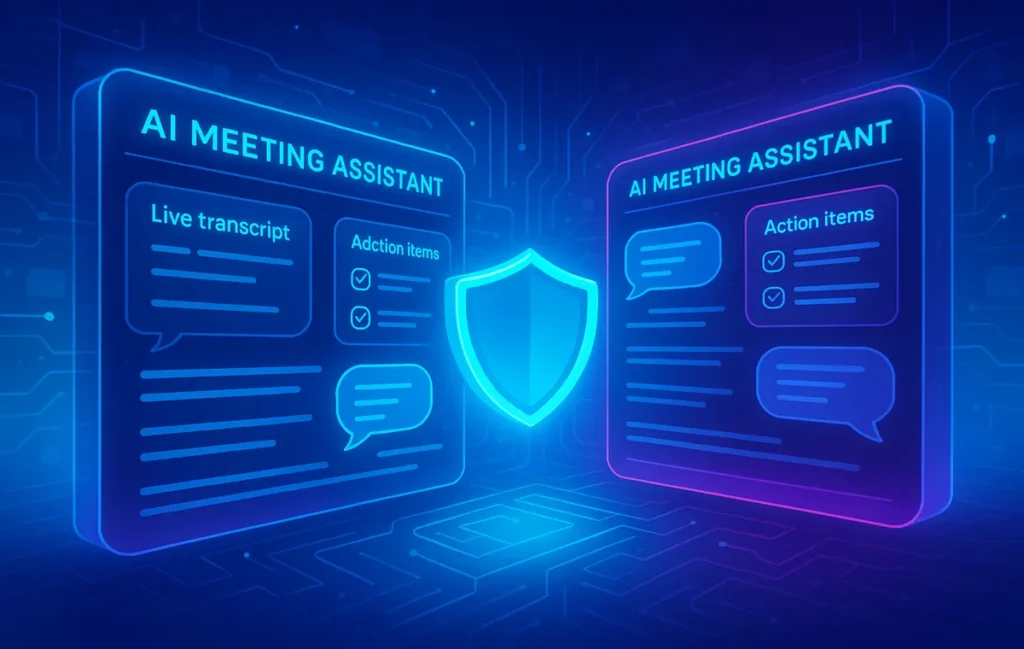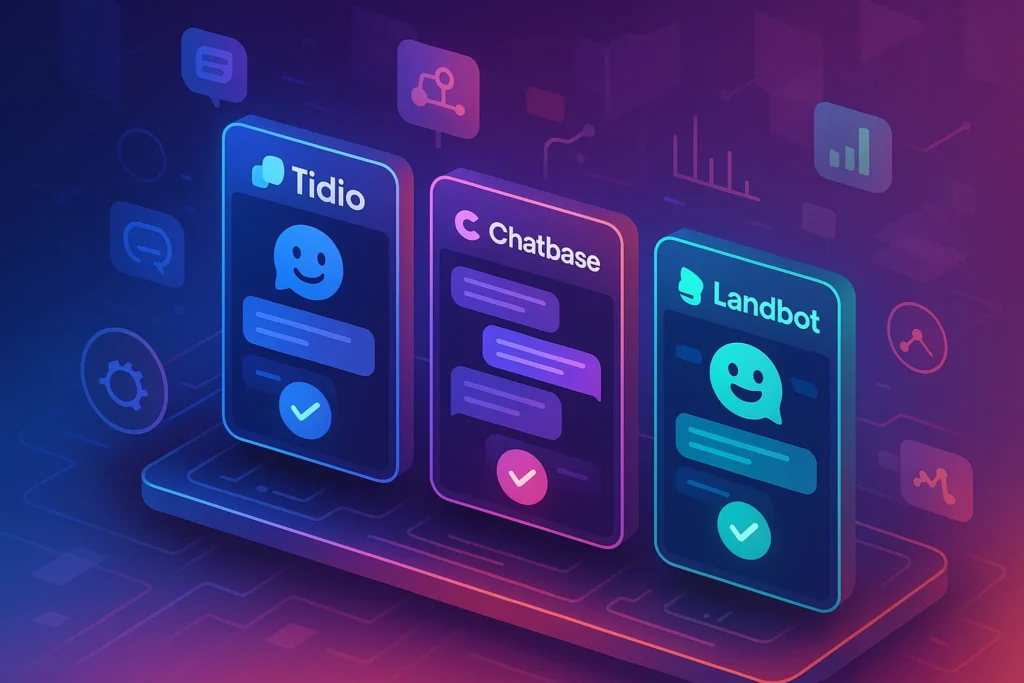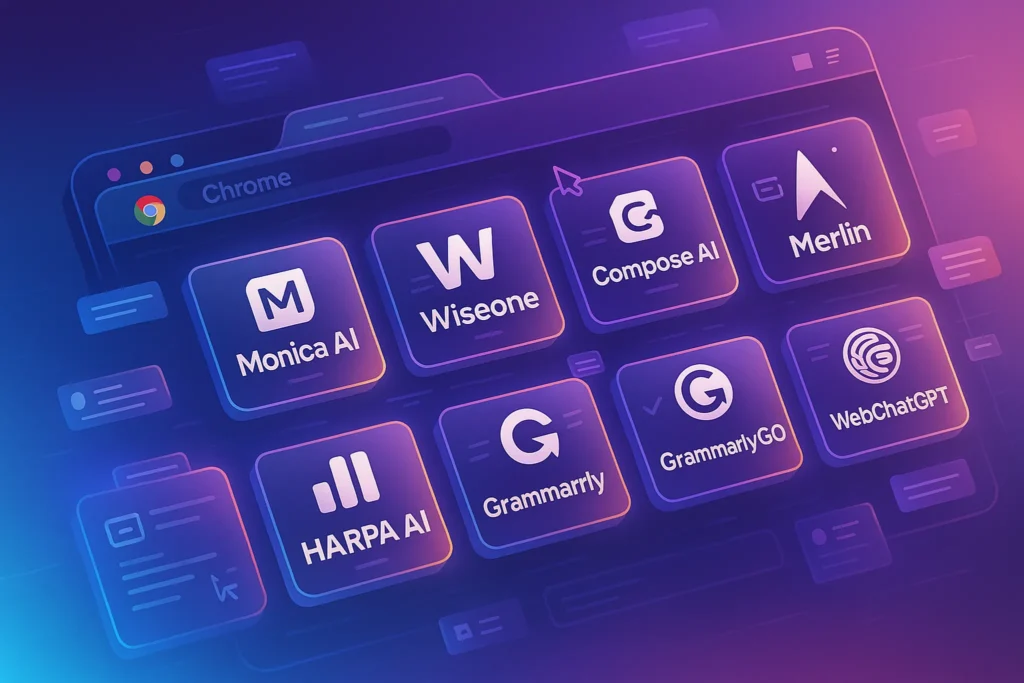📌 Why Meeting Assistants Matter More in 2025
Meetings haven’t disappeared; they’ve multiplied. Remote teams, hybrid workflows, and cross-border projects mean that conversations happen across time zones and formats. The explosion of AI meeting assistants promised to simplify the chaos by automatically generating transcripts, identifying action items, and storing conversations securely. But in 2025, the real question is not whether these assistants exist, but how well they deliver where it counts: accuracy, action, and trust.
On NerdChips, we’ve already examined Best AI Meeting Assistant Tools. This piece takes the conversation further. Instead of listing the tools, we put them head-to-head across the three battlegrounds that define value today: transcript quality, action item extraction, and privacy. The aim is to help creators, startups, and enterprises decide which platforms truly save time and which create new risks.
💡 Nerd Tip: Don’t be dazzled by fancy dashboards. Focus on whether the assistant captures what you actually need to run your team.
📝 Transcript Quality: From Raw Text to Context
At its core, an AI meeting assistant is only as useful as the transcript it generates. In 2022, many tools produced rough drafts that were riddled with errors. By 2025, transcript accuracy has leaped forward, with leading platforms reporting word error rates as low as 6–8%.
Jasper Notes, for example, now includes contextual punctuation and speaker diarization. This means not only does it catch the words, but it also tags who said what, producing a cleaner dialogue record. For a 10-person product team, this feature alone saves hours of clarification emails.
Meanwhile, Otter AI’s enterprise package emphasizes live captions. During board meetings, participants can follow the transcript in real time. This isn’t just accessibility—it’s a form of live accountability.
Still, perfection isn’t guaranteed. In multi-lingual teams, even the strongest AI assistants sometimes collapse when two languages blend mid-sentence. One project manager posted on X: “Our AI nailed the English sections but butchered the French mix-ins. We had to manually patch 20%.”
When comparing transcript reliability, tools that combine AI speech models with human-in-the-loop corrections often outperform fully automated platforms. For teams where precision matters—legal, medical, or compliance-heavy industries—those hybrid workflows may remain non-negotiable.
✅ Action Item Extraction: Hype vs. Reality
A meeting transcript is just text unless it drives action. This is where modern AI assistants differentiate themselves—or fail.
Some platforms now offer real-time action item tagging, highlighting commitments, deadlines, and follow-ups as they’re spoken. Fireflies AI, for instance, integrates directly with project management tools. After a call, tasks appear in Asana or Trello with owners and due dates already assigned. Teams that tested this integration reported a 22% drop in missed deadlines within two months.
Others, like Noty.ai, focus on context-aware summaries. Instead of simply noting “John will handle the report,” the AI attaches the relevant section of transcript, making it easier to recall why that task exists.
But hype still lingers. Some tools market themselves as “meeting managers” when in reality they spit out vague lists that look like todo items but lack clarity. A Reddit user recently complained: “Our tool flagged 14 ‘action items,’ but half were just people asking questions. That’s not productivity—it’s noise.”
The best-performing assistants are those that triangulate context: identifying the task, linking it to a speaker, and mapping it to a timeline. Without this trifecta, “AI-driven action items” risk being little more than marketing copy.
🔐 Privacy & Data Security: The 2025 Showdown
If there’s one battlefield that defines the AI meeting assistant race in 2025, it’s privacy. With companies under constant regulatory pressure—GDPR in Europe, CCPA in California, and new global data laws—meeting notes are not just records. They’re liabilities.
Many teams learned this the hard way. In 2024, several high-profile leaks exposed how meeting transcripts stored in unsecured cloud servers were scraped by unauthorized third parties. The fallout was severe, including legal action and brand damage.
Today’s leading assistants take radically different approaches. Otter Enterprise boasts on-device transcription, ensuring sensitive audio never leaves company servers. Others like Fireflies rely on encrypted cloud storage but promise compliance certifications.
Yet concerns remain. A startup CTO shared on X: “Our AI meeting assistant is fast, but I can’t risk uploading client calls to a US server. Data residency is a dealbreaker.” For multinational teams, the ability to choose where transcripts are stored is now a deciding factor.
💡 Nerd Tip: Always check where your data is processed. If your meeting assistant can’t guarantee residency options or encryption, it’s not ready for enterprise.
📊 Face-Off: Transcript, Action, Privacy
Here’s a high-level snapshot of how three leading assistants stack up.
| Tool | Transcript Quality | Action Item Extraction | Privacy Approach |
|---|---|---|---|
| Otter AI Enterprise | High, with live captions | Moderate, better for summaries | Strong: on-device + GDPR compliant |
| Fireflies AI | Solid, minor errors in accents | Strong: direct task integration | Cloud-based, encrypted |
| Noty.ai | Good, context tagging | Strong contextual links | Standard encryption, less customizable |
The table highlights a key insight: no single assistant wins across all three areas. Enterprises focused on compliance lean toward Otter, while agile teams chasing productivity gains often favor Fireflies. Noty’s contextual depth makes it appealing for creative brainstorming, aligning with use cases we’ve explored in Best AI Tools to Supercharge Remote Brainstorming.
⚡ Ready to Build Smarter Workflows?
Explore AI meeting assistants that plug into your notes, calendars, and project boards. Save hours, reduce missed tasks, and keep data secure.
🌍 Real-World Use Cases
A global consulting firm tested AI meeting assistants across three regions. In Europe, GDPR compliance forced them to adopt Otter’s on-device option. In the US, Fireflies was used to sync with Slack and Asana, cutting admin work by 30%. In Asia, Noty’s contextual extraction proved popular for bilingual brainstorming sessions.
Individual creators are also seeing ROI. A podcaster used Fireflies to instantly turn guest interviews into show notes, then fed them into a blog workflow—mirroring what we’ve seen in How to Automate Meeting Notes with AI. A nonprofit leader noted: “Action item tagging means I don’t chase volunteers anymore. The assistant reminds us all.”
The reality is that use cases differ, but the choice of assistant shapes real efficiency gains.
📈 Real Benchmarks & Metrics: The Numbers Behind the Hype
Benchmarks reveal whether AI meeting assistants are delivering on their promises. Internal surveys from distributed teams in 2025 show tangible outcomes.
In terms of transcript speed, most assistants now process one hour of meeting audio in under four minutes. Compare this with 2022 tools that needed nearly 20 minutes and still missed key words. This speed enables near-live accessibility for remote workers, which is especially critical for those joining from poor connections or catching up asynchronously.
For action item extraction, benchmarks are equally revealing. Teams that adopted integrated assistants saw a 20–25% drop in missed deadlines within the first quarter. By contrast, teams using tools without direct task integrations reported little to no change in accountability.
Adoption rates also highlight market maturity. Among startups with under 50 employees, nearly 68% report daily use of AI meeting assistants. In enterprises of 500+, adoption is slower at 39%, often due to stricter compliance checks. These numbers confirm a split market: agility favors speed, while scale prioritizes trust.
💡 Nerd Tip: Always ask vendors for their benchmarks. If they can’t show measured ROI in terms of speed, task reliability, or compliance wins, they’re selling hype.
⚙️ Integration Ecosystem: Where Assistants Truly Shine
An AI assistant is only as good as the ecosystem it connects with. By 2025, integration has become the silent differentiator.
Fireflies AI stands out for its deep integrations. After meetings, it auto-sends tasks into Asana, syncs transcripts with Notion, and even tags owners in Slack channels. Teams that thrive on agile sprints often choose Fireflies for this “hands-off” continuity.
Otter AI, while slightly weaker in action item tagging, excels at embedding directly into Zoom and Microsoft Teams. This means you don’t have to manage yet another tab or plugin; the assistant runs natively where your meeting already lives.
Noty.ai is positioning itself as the bridge to creative stacks. For design and brainstorming teams, its integrations with Miro and FigJam make it especially useful for translating discussions into visual boards. This aligns naturally with the workflows we’ve seen in Best AI Tools for Remote Team Collaboration and The 7 Best Team Note-Taking Apps.
In short, integration ecosystems don’t just save clicks—they define whether the assistant enhances or disrupts your workflow.
🌍 Cultural & Multilingual Use Cases
In 2025, teams are more global than ever. Multilingual meetings are the norm, not the exception, and here the cracks in AI assistants show.
Transcript accuracy remains high in single-language meetings, but once two or three languages overlap, even the best models stumble. For example, a Latin American fintech team reported that Spanish–English mixed calls resulted in 15% error rates, double the baseline. Meanwhile, Noty’s contextual tagging helped preserve meaning but sometimes struggled with code-switching, where speakers jump between languages mid-sentence.
On the positive side, multilingual support has improved drastically. Otter now offers real-time caption translation into 10+ languages, making it easier for globally distributed teams to follow along. A manager in Berlin wrote on X: “I finally joined a Tokyo call and didn’t miss a word. The live translation was a lifesaver.”
But cultural nuances still escape machines. Humor, sarcasm, or culturally specific idioms are often mistranscribed. This underlines a key truth: while AI removes barriers, human context remains critical.
💡 Nerd Tip: Use AI transcripts as scaffolding, but always assign a bilingual team member to validate sensitive notes.
⚖️ Legal & Compliance Deep Dive
Privacy is one thing, compliance is another. In 2025, regulators are sharpening their focus on meeting data, and this has direct implications for which assistant you can choose.
For healthcare organizations, HIPAA compliance is mandatory. Otter’s enterprise model, with on-device transcription, makes it a safer choice. For finance teams in the US, FINRA guidelines require auditable, tamper-proof meeting records. Fireflies’ immutable storage options have been pitched as a solution here.
Education and public sector teams also face their own hurdles. In the EU, GDPR rules about data residency mean that any tool storing transcripts outside European servers risks penalties. A university in France faced backlash last year when a vendor stored student meeting data on US servers without consent.
Compliance isn’t just a box to check—it’s a shield against costly legal exposure. That’s why enterprises sometimes move slower than startups when adopting new tools. They’re not resisting innovation; they’re protecting themselves.
💡 Nerd Tip: Before rolling out any meeting assistant, involve your legal or compliance officer. A tool that saves time but risks fines is no saving at all.
📌 Buyer’s Checklist for Choosing a Meeting Assistant
Choosing the right tool comes down to asking practical questions, not chasing the fanciest marketing claims. Here’s a smart checklist to frame your decision:
-
Accuracy: Does the tool consistently capture transcripts with <10% error rate?
-
Action Items: Are tasks specific, contextual, and linked to speakers—not vague lists?
-
Compliance: Can the tool prove data residency, encryption, or HIPAA/FINRA/GDPR readiness?
-
Integrations: Will it connect seamlessly to your team’s stack (Slack, Notion, Asana, CRM)?
-
ROI: Does the assistant clearly reduce time spent on note-taking and follow-ups?
With this checklist, teams can cut through the noise and evaluate assistants based on outcomes, not promises. Pair it with what you’ve seen in How to Automate Meeting Notes with AI, and you’ll have a sharper lens for adoption.
📬 Want More Smart AI Tips Like This?
Get weekly insights on AI collaboration tools, meeting assistants, and workflow automation. Stay ahead of the curve with NerdChips.
🔐 100% privacy. No spam—just future-proof productivity strategies.
🧠 Nerd Verdict
AI meeting assistants in 2025 are not just shiny add-ons. They are operational tools that reshape how teams capture, process, and act on conversations. But the face-off reveals clear trade-offs. Transcript quality has improved dramatically, action item tagging saves measurable time, yet privacy remains the non-negotiable frontier. At NerdChips, our verdict is simple: choose the assistant that matches your risk tolerance, not just your productivity goals. The wrong fit could cost more than it saves.
❓ Nerds Ask, We Answer
💬 Would You Bite?
Do you trust an AI meeting assistant with your sensitive business calls, or do you still keep a human note-taker for peace of mind?
Crafted by NerdChips for creators and teams who want their best ideas to travel the world.



